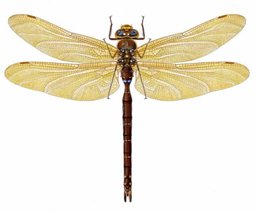| Aeshna
grandis |
 |
|
Common Name:
|
Brown Hawker |
|
Odonata |
|
Order:
|
Odonata |
|
Suborder:
|
Anisoptera |
|
Family:
|
Aeshnidae |
|
Genus:
|
Aeshna |
|
Species:
|
A. grandis |
|
|
| The
Name |
| Aeshna grandis (Linnaeus, 1758),
the Brown Hawker, is a large dragonfly about 73 mm long. It is a distinctive
species and is easily recognised, even in flight, by its brown body and
bronze wings. At rest, blue spots on the second and third segments of the
male's abdomen can be noticed; these are absent in female.
It is widespread in England but commonest
in the South East; local in Ireland and absent from Scotland. It is found
on well-vegetated ponds, lakes and canals. It patrols a regular hunting
territory around margins which is vigorously defended against intruders.
|
| The
Characteristics |
| Length around 73mm, windspan around
102mm. This is a large Hawker with obvious golden brown wings. Both sexes
have strong yellow stripes on the sides of the thorax and no ante-humeral
stripes. The male is chocolate brown with small blue and yellow markings.
It has a noticeable waisted appearence. The female has small yellow markings
and lacks the males waist.
Aeshna grandis stands out from other
Aeshna dragonflies due to its overall brown colour a touch of which even
returns on its wings. This makes the appearance of this dragonfly quite
impressive during flight as the slightly darker wings make it look larger.
|
| The
Reproduction and Development |
| Breeds in standing or slow-flowing
water laying its eggs in floating or emergent vegetation or timber. Hunts
well away from water and may be found hawking woodland rides well into
the evening.
Males are territorial holding territories
at water bodies or away from water. Copulation occurs away from water in
vegetation. Females oviposit alone placing eggs into wet mud, wet deadwood
or aquatic and marginal plants.
Eggs overwinter and hatch in spring.
Larvae live amongst submerged water plants or amongst plant debris. Development
takes 2-4 years according to locality. Recorded food items include chironomid
larvae (up to 50% of diet in some studies), adult flies and Zygoptera from
water surface. Larvae can also be cannibalistic. Emergence happens low
down on marginal vegetation at night.
Preferred environment are mesotrophic
and eutrophic, sheltered lowland lakes and ponds. Also canals and flooded
disused gravel pits. Flight period from end of June to the end of October.
|
| The
Distribution |
Ranged northern and central Europe
from the Pyrenees to northern Finland; Asia to Lake Baikal region.
|
| The
Protection Status |
| Common and abundant throughout its
range. |
|
References:
http://en.wikipedia.org/wiki/Brown_Hawker
http://www.habitas.org.uk/dragonflyireland/5625d.htm
|
| The
Species on Stamps |
|
|
|
|
With courteous to Mr. Richard
Lewington for the Dragonfly Illustration
|
|
|
|
Home | Country
List | Species List
|